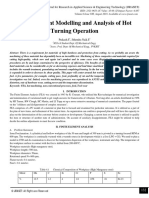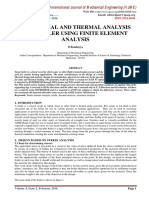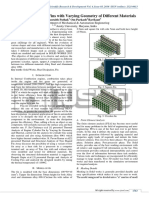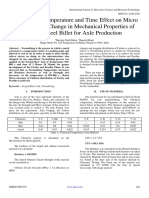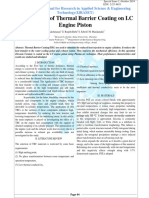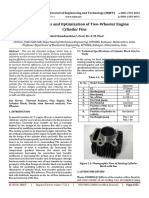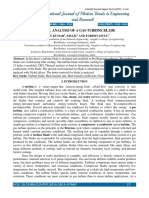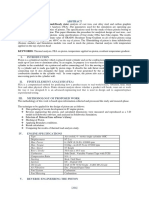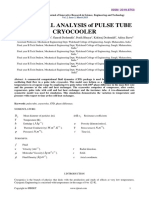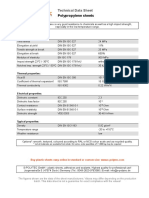Design and Analysis of Gas Turbine Blade: ISSN: 2319-8753 I J I R S E T
Design and Analysis of Gas Turbine Blade: ISSN: 2319-8753 I J I R S E T
Uploaded by
maji heCopyright:
Available Formats
Design and Analysis of Gas Turbine Blade: ISSN: 2319-8753 I J I R S E T
Design and Analysis of Gas Turbine Blade: ISSN: 2319-8753 I J I R S E T
Uploaded by
maji heOriginal Title
Copyright
Available Formats
Share this document
Did you find this document useful?
Is this content inappropriate?
Copyright:
Available Formats
Design and Analysis of Gas Turbine Blade: ISSN: 2319-8753 I J I R S E T
Design and Analysis of Gas Turbine Blade: ISSN: 2319-8753 I J I R S E T
Uploaded by
maji heCopyright:
Available Formats
ISSN: 2319-8753
International Journal of Innovative Research in Science,
Engineering and Technology
(An ISO 3297: 2007 Certified Organization)
Vol. 3, Issue 6, June 2014
Design and Analysis of Gas Turbine Blade
Theju V1, Uday P S 2, PLV Gopinath Reddy 3, C.J.Manjunath 4
U G student, Department of Aeronautical Engineering, SCE, Chikkaballapura, Karnataka, India1.
U G student, Department of Aeronautical Engineering, SCE, Chikkaballapura, Karnataka, India2.
U G student, Department of Aeronautical Engineering, SCE, Chikkaballapura, Karnataka, India3.
Asst.Professor, Department of Mechanical Engineering, SCE, Chikkaballapura, Karnataka, India4.
ABSTRACT- The objective of this project is to design and stresses analyze a turbine blade of a jet engine. An
investigation for the usage of new materials is required. In the present work turbine blade was designed with two different
materials named as Inconel 718 and Titanium T-6. An attempt has been made to investigate the effect of temperature and
induced stresses on the turbine blade. A thermal analysis has been carried out to investigate the direction of the temperature
flow which is been develops due to the thermal loading. A structural analysis has been carried out to investigate the
stresses, shear stress and displacements of the turbine blade which is been develop due to the coupling effect of thermal and
centrifugal loads. An attempt is also made to suggest the best material for a turbine blade by comparing the results obtained
for two different materials (Inconel 718 and titanium T6). Based on the plots and results Inconel718 can be consider as the
best material which is economical, as well as it has good material properties at higher temperature as compare to that of
TitaniumT6.
I. INTRODUCTION
The gas turbine obtains its power by utilizing the energy of burnt gases and the air which is at high temperature and
pressure by expanding through the several rings of fixed and moving blades. The turbine drives the compressor so it is
coupled to the turbine shaft. After compression, the working fluid were to be expanded in a turbine, then assuming that
there were no losses in either component, the power developed by the turbine can be increased by increasing the volume of
working fluid at constant pressure or alternatively increasing the pressure at constant volume. Either of there may be done
by adding heat so that the temperature of the working fluid is increased after compression. To get a higher temperature of
the working fluid, a combustion chamber is required where combustion of air and fuel takes place giving temperature rise
to the working fluid. The turbine escapes energy from the exhaust gas. The present paper deals with the first type is
centrifugal stresses that act on the blade due to high angular speeds and second is thermal stresses that arise due to
temperature gradient within the blade material. The analysis of turbine blade mainly consists of the following two parts:
Structural and thermal analysis. The analysis is carried out under steady state conditions using ANSYS software. The study
has been conducted with two different materials Inconel 718 and Titanium T6.
II. LITERATURE SURVEY
V.Veeraragavan [5] had mainly done the research on the aircraft turbine blades; his main focus was on 10 C4/ 60 C50
turbine blades models. He had used the conventional alloys such as titanium, zirconium, molybdenum, and super alloys
were chosen for the analysis. He had analyzed the effect of the temperature on the different material for the certain interval
of times. And conclude the molybdenum alloys had better temperature resistance capability.
Copyright to IJIRSET www.ijirset.com 13533
ISSN: 2319-8753
International Journal of Innovative Research in Science,
Engineering and Technology
(An ISO 3297: 2007 Certified Organization)
Vol. 3, Issue 6, June 2014
R D V Prasad, G Narasa Raju, M S S Srinivasa Rao, N Vasudeva Rao [7] had done research on different types of
the cooling technique which maintain temperature of the blade to allowable limits, Finite element analysis is used to
examine steady state thermal & structural performance for N155 & Inconel 718 nickel-chromium alloys. Four different
models consisting of solid blade and blades with varying number of holes (5, 9 & 13 holes) were analyzed to find out
the optimum number of cooling holes. They had used two material Inconel 718 and Inconel 155 for their research work
and found out Inconel 718 has the better thermal properties as the blade temperature and the stress induce is lesser.
III. METHODOLOGY
1. Problem definition.
2. Calculate the dimensions of blade profile
3. Generate the 3-dimentional computer models
4. Prepare finite element model of the 3D computer model
5. Preprocess the 3D model for the defined geometry
6. Mesh the geometry model and refine the mesh considering sensitive zones for results accuracy
7. Post process the model for the required evaluation to be carried out
8. Determine maximum stress induced in blades.
9. Determine the temperature distribution along the blade profile.
10. Conclude the results.
IV. DESIGN AND CAD MODELLING
By using standard assumptions, theoretical calculations are made to obtain the dimensions of the blade geometry. . The
design parameters are given in table 4.1
Table 4.1: Design parameters.
PARAMETER VALUE UNIT
Blade height, h 0.081833 m
Chord width, c 0.02727 m
Pitch, s 0.02264 m
Number of blade 69
Blade inlet angle, β 2 18.30 deg
Blade outlet angle, β3 54.56 0 deg
Mean radius, rm 0.2475 m
Copyright to IJIRSET www.ijirset.com 13534
ISSN: 2319-8753
International Journal of Innovative Research in Science,
Engineering and Technology
(An ISO 3297: 2007 Certified Organization)
Vol. 3, Issue 6, June 2014
The 3D CAD model is created using the software CATIA V5; it is shown in fig 4.1.
Fig 4.1: - Sector Model of Turbine Blade
.
V. DETAILS OF TURBINE BLADE MATERIAL
The turbine blade is subjected to rotational speed of 10800 rpm and firing temperature of 619 0C. Factor of safety is 1.6.
Table 5.1:-Material properties.
Properties Unit Inconel 718 Titanium
T6
Young’s modulus MPa 2E5 1.06E5
3
Density kg/m 8193.3 4420
Poisson’s ratio 0.31 0.3
Tensile yield strength MPa 1069 530
Allowable stress MPa 641.8 318
Allowable MPa 385.08 190.8
Shear stress
Specific heat J/kg-K 556.85 527.5
VI. RESULTS AND DISCUSSION
The temperature distribution of the blade depends on the heat transfer coefficient for gases and the thermal conductivity of
the material. The heat transfer coefficients are calculated by iterative process and the same were adopted. The analysis was
carried out for steady state heat transfer conditions. It is observed that the maximum temperatures are prevailing at the
Copyright to IJIRSET www.ijirset.com 13535
ISSN: 2319-8753
International Journal of Innovative Research in Science,
Engineering and Technology
(An ISO 3297: 2007 Certified Organization)
Vol. 3, Issue 6, June 2014
leading edge of the blade due to the stagnation effects. The body temperature of the blade doesn’t vary much in the radial
direction. However, there is a temperature fall from the leading edge to the trailing edge of the blade as expected. It is
observed for solid blade model from fig6.1 (Titanium T6) and fig6.2 (Inconel 718), that the blade temperatures attained for
Inconel 718 are marginally lower. This can be attributed to the lower thermal conductivity of Inconel 718.
Fig 6.1:- Temperature distribution on Titanium T6. Fig 6.2: -Temperature distribution on Inconel 718.
The temperatures obtained from the thermal analysis are imported to structural analysis. The Centrifugal forces acting on
the blade are considered as loads in structural analysis.
Fig 6.3:- Von-miss stress on Inconel Fig 6.4:- Von-miss stress on Titanium T6
Below fig 6.3, fig 6.4, shows the variation of the von misses stress on the blade and the drum portion, Inconel 718 and
titanium T-6 was use in blade whereas steel 286 was use for the drum. As the blades are not shrouded so the stress on the
tip of the blade are lesser and higher values of stress is coming on the root of the blades.
Copyright to IJIRSET www.ijirset.com 13536
ISSN: 2319-8753
International Journal of Innovative Research in Science,
Engineering and Technology
(An ISO 3297: 2007 Certified Organization)
Vol. 3, Issue 6, June 2014
Fig 6.5:- Total deformation of Inconel 718 Fig 6.6:- :- Total deformation of Titanium T6
Thermal expansion of Titanium-T6 is lesser as compare to that of Inconel 718; due to this property of the materials the
expansion of the Titanium T6 is lesser as compare to that of Inconel 718. The results are shown in table 6.1.
Table 6.1: Comparison of results.
PARAMETERS INCONEL 718 TITANIUM T6
Total Deformation(mm) 1.0448 0.90901
Analytical Computational Analytical Computational
Results Results Results Results
Von Misses Stress(MPa) 641.8 621 318 301.3
VII. CONCLUSION
It is seen from above results both the materials are giving the considerable results; finally the conclusion can be
done on the basis of the cost and the availability of the materials.
If cost of the materials is not a primary issue we can select the titanium T6 which have lesser density, lesser value
of deformation at a same time it will have lower value of yield strength and young modulus at higher temperature,
which will have a lower strength.
On the other hand if cost of the material is a primary issue then we can select Inconel 718, it will have little higher
deformation at high temperature as compare to titanium T6. But at the same time it will have higher value of
elastic strength, higher values of yield strength which will induce lesser value of the stress on the blade.
It is also seen Inconel 718 have good material properties at higher temperature has compare to that of the titanium
T6.
Copyright to IJIRSET www.ijirset.com 13537
ISSN: 2319-8753
International Journal of Innovative Research in Science,
Engineering and Technology
(An ISO 3297: 2007 Certified Organization)
Vol. 3, Issue 6, June 2014
Proper way of cooling should be adopted such that hot corrosion and creep strain distribution on the trailing edge
will get minimized on turbine blade (Inconel 718)
So we can conclude from above plots and observation that structure is safe for given loading condition and also,
Inconel 718 is better material as compare to that of titanium T6 in economically as well as strength at higher
temperatures.
REFERENCES
1. S.Gowreesh, N.Sreenivasalu Reddy and N.V.Yogananda Murthy. “CONVECTIVE HEAT TRANSFER ANALYSIS OF AERO GAS TURBINE
BLADE USING ANSYS”, International journal of Mechanics of solids, vol4, No.1, March 2009(ppt55-62).
2. P.Kauthalkar, Mr.Devendra S.Shikarwar, and Dr.Pushapendra Kumar Sharma. “ANLYSIS OF THERMAL STRESES DISTRIBUTION PATTERN
ON GAS TURBINE BLADE USING ANSYS”, International journal of Engineering Education and technology, Vol.2, No.3, Nov 2010.
3. John.V, T.Ramakrishna. “THE DESIGN AND ANALYSIS OF GAS TURBINE BLADE”, International Journal of Advanced Research and Studies,
Vol 2, No.1, Dec 2012.
4. V.Raga Deepu, R.P.Kumar Ropichrla. “DESIGN AND COUPLED FIELD ANALYSIS OF FIRST STAGE GAS TURBINE ROTOR BLADES”,
International journal of Mathematics and Engineering, Vol 13, No.2, Pages: 1603-1612.
5. V. Veeraragavan Effect Of Temperature Distribution In 10c4/60c50 Gas Turbine Blade Model Using Finite Element Analysis.
6. V.R.S.M. Kishore Ajjarapu1, K. V.P.P.Chandu2 D.M.Mohanthy Babu3 “DESIGN AND ANALYSIS OF THE IMPELLER OF A
TURBOCHARGER FOR A DIESEL ENGINE”
1 2 3 4
7. R D V Prasad , G Narasa Raju , M S S Srinivasa Rao , N Vasudeva Rao Steady State Thermal & Structural Analysis of Gas Turbine Blade Cooling
System.
8. Timoshenko, “STRENGTH OF MATERIALS PART 1” third edition.
9. Jack D Mattingly, “Elements of Propulsion: Gas Turbine and Rockets”.
10. H.S.Manohar , Finite Element Method ,first edition.
11. Singiresu S. Rao, “The Finite Element Method in Engineering”.
BIOGRAPHY
Mr. Uday .P.S. persuing Aeronautical Engineering, 8th semester from Sha-Shib of Engineering,
Chikkaballapura, Karnataka. Published papers in national & International journals on aeronautical topics.
Ms. Theju.V, persuing Aeronautical Engineering, 8 th semester from Sha-Shib of Engineering,
Chikkaballapura, Karnataka. Published papers in International journals.
Copyright to IJIRSET www.ijirset.com 13538
ISSN: 2319-8753
International Journal of Innovative Research in Science,
Engineering and Technology
(An ISO 3297: 2007 Certified Organization)
Vol. 3, Issue 6, June 2014
Mr. Pagidala L V Gopinath Reddy, persuing Aeronautical Engineering, 8th semester from Sha-Shib of
Engineering, Chikkaballapura, Karnataka. Published papers at national level on aeronautical topics.
Mr. Manjunath C.J. presently working as Asst. Professor in Sha-Shib of Engineering, Bangalore. He did
his M. tech in Machine Design from Nagarjuna College of Engineering & Technology, Karnataka. He has
published several papers in National & International Journals. He has attended several workshops of
Machine design & manufacturing technology. His research area is in Vibrations.
Copyright to IJIRSET www.ijirset.com 13539
You might also like
- BS en 15497-2014Document62 pagesBS en 15497-2014Amer AmeryNo ratings yet
- Industrial Products Catalogue METALASTIK & NOVIBRADocument92 pagesIndustrial Products Catalogue METALASTIK & NOVIBRADanijelNo ratings yet
- ICC-ES-AC 86-0619-AltDocument10 pagesICC-ES-AC 86-0619-AltrcNo ratings yet
- Field Joint CoatingDocument12 pagesField Joint CoatingkatfyNo ratings yet
- Textile Testing and Product EvaluationDocument64 pagesTextile Testing and Product EvaluationAnmol Jain100% (3)
- PaperpublisherudayDocument8 pagesPaperpublisherudayDeniz AtmacaNo ratings yet
- JETIR2304485Document16 pagesJETIR2304485svvsnrajuNo ratings yet
- Structural Design and Analysis of Gas Turbine Blade Using Cae Tools IJERTV3IS100482Document6 pagesStructural Design and Analysis of Gas Turbine Blade Using Cae Tools IJERTV3IS100482Sai SushmaNo ratings yet
- Finite Element Modelling and Analysis of Hot Turning OperationDocument15 pagesFinite Element Modelling and Analysis of Hot Turning OperationIJRASETPublicationsNo ratings yet
- Design and Analysis of Gas Turbine BladeDocument7 pagesDesign and Analysis of Gas Turbine BladeFurqanNo ratings yet
- Thermal Fatigue Analysis of Exhaust ManifoldDocument11 pagesThermal Fatigue Analysis of Exhaust ManifoldIJRASETPublicationsNo ratings yet
- Structural Analysis of Gas Turbine Blade by Using ANSYS 1Document5 pagesStructural Analysis of Gas Turbine Blade by Using ANSYS 1Nitin SinghNo ratings yet
- CFD Analysis and Optimization of Pin Fin Heat SinkDocument6 pagesCFD Analysis and Optimization of Pin Fin Heat Sinksb8862No ratings yet
- IJTIMESV05I05150531142334Document8 pagesIJTIMESV05I05150531142334Sheila KorirNo ratings yet
- Heat Transfer Analysis of Engine Cylinder Fins Having Triangular ShapeDocument10 pagesHeat Transfer Analysis of Engine Cylinder Fins Having Triangular ShapeGovar AnjaneyuluNo ratings yet
- Modeling and Analysis of Steam Turbine Blade-Ijaerdv05i0451562n PDFDocument11 pagesModeling and Analysis of Steam Turbine Blade-Ijaerdv05i0451562n PDFGuruvenu KamanuruNo ratings yet
- Structural and Thermal Analysis On Gas Turbine Blade Using Solid WorksDocument4 pagesStructural and Thermal Analysis On Gas Turbine Blade Using Solid WorksSeth Ferrara100% (1)
- Numerical Study and Analysis of Gas Turbine BladesDocument8 pagesNumerical Study and Analysis of Gas Turbine BladesTJPRC PublicationsNo ratings yet
- Thermal Analysis-2628 PDFDocument11 pagesThermal Analysis-2628 PDFgirish sbNo ratings yet
- Ijmet 08 01 005 PDFDocument9 pagesIjmet 08 01 005 PDFIAEME PublicationNo ratings yet
- Structural and Thermal Analysis of A Boiler Using Finite Element AnalysisDocument5 pagesStructural and Thermal Analysis of A Boiler Using Finite Element AnalysismohanNo ratings yet
- BVKSwamyAyyappa AVSridhar SRajasekhar A 39Document7 pagesBVKSwamyAyyappa AVSridhar SRajasekhar A 39alinoorhamdani76No ratings yet
- A Simple Thermistor Design For Industrial TemperatDocument11 pagesA Simple Thermistor Design For Industrial TemperatBimal JalanNo ratings yet
- Ijresm 19 84Document5 pagesIjresm 19 84ahmed aliNo ratings yet
- Venukumar 2018Document6 pagesVenukumar 2018Waqas MuneerNo ratings yet
- Diseño de Una Turbina A GasDocument6 pagesDiseño de Una Turbina A GasCristian JimenezNo ratings yet
- Comparative Thermal Analysis of Fin of I.C. Engine With Extensions IJERTV6IS040377 PDFDocument8 pagesComparative Thermal Analysis of Fin of I.C. Engine With Extensions IJERTV6IS040377 PDFAhmad FaizalNo ratings yet
- 16 UltrasonicDocument7 pages16 UltrasonicBilal AhmedNo ratings yet
- Thermal Analysis of Fins With Varying Geometry of Different MaterialsDocument3 pagesThermal Analysis of Fins With Varying Geometry of Different Materialspurrab divakarNo ratings yet
- Remaining Life Assessment of Refinery FuDocument4 pagesRemaining Life Assessment of Refinery FuJose Marval RodriguezNo ratings yet
- Workability Study On Austempered AISI 1018Document8 pagesWorkability Study On Austempered AISI 1018MohanNo ratings yet
- Thermal Analysis and Optimization of I.C. Engine Piston Using Finite Element MethodDocument11 pagesThermal Analysis and Optimization of I.C. Engine Piston Using Finite Element MethodDekassyah IdNo ratings yet
- Dissimilar - Metal - Welds - of - Stainless SteelDocument5 pagesDissimilar - Metal - Welds - of - Stainless SteelBassam AbdelazeemNo ratings yet
- Design and Fabrication of A Furnace To Investigate High Temperature Deformation BehaviourDocument29 pagesDesign and Fabrication of A Furnace To Investigate High Temperature Deformation BehaviourDeepjyoti DasNo ratings yet
- Normalizing Temperature and Time Effect On Micro Structure and Change in Mechanical Properties of Forged Steel Billet For Axle ProductionDocument3 pagesNormalizing Temperature and Time Effect On Micro Structure and Change in Mechanical Properties of Forged Steel Billet For Axle ProductionAnonymous izrFWiQNo ratings yet
- Turbine Blade Design of A Micro Gas Turbine: Vellore Institute of Technlogy, Vellore - 632014, IndiaDocument6 pagesTurbine Blade Design of A Micro Gas Turbine: Vellore Institute of Technlogy, Vellore - 632014, Indiakamran kainporNo ratings yet
- Heat Transfer Enhancement Using Nanoparticles (Al2o3)Document6 pagesHeat Transfer Enhancement Using Nanoparticles (Al2o3)IJRASETPublicationsNo ratings yet
- Ijesrt: International Journal of Engineering Sciences & Research TechnologyDocument8 pagesIjesrt: International Journal of Engineering Sciences & Research TechnologyJohn RobinsonNo ratings yet
- Investigation of Thermal Barrier Coating On I.C Engine PistonDocument5 pagesInvestigation of Thermal Barrier Coating On I.C Engine PistonShreeram BakthaNo ratings yet
- Development of Temperature Measurement Setup For MDocument6 pagesDevelopment of Temperature Measurement Setup For MBalázs SimonNo ratings yet
- Thermal Analysis and Optimization of Two-Wheeler Engine Cylinder FinsDocument8 pagesThermal Analysis and Optimization of Two-Wheeler Engine Cylinder FinsSYED KHAJA nizam uddinNo ratings yet
- Design and Analysis of A Gas Turbine Blade by Using FEM: L.UmamaheswararaoDocument6 pagesDesign and Analysis of A Gas Turbine Blade by Using FEM: L.UmamaheswararaoMohdShahidNo ratings yet
- Ansys PistonDocument8 pagesAnsys Pistonantedeguemon166No ratings yet
- Thermal Analysis of A Gas Turbine BladeDocument13 pagesThermal Analysis of A Gas Turbine Blademanufacturing Tech airfieldNo ratings yet
- Effect of Geometry, Material and Thickness of Fin On Engine Cylinder FinsDocument6 pagesEffect of Geometry, Material and Thickness of Fin On Engine Cylinder FinsAnonymous kw8Yrp0R5rNo ratings yet
- Springback in TI64Document7 pagesSpringback in TI64Harsh Vardhan SinghNo ratings yet
- 219 - Daniel AntonyDocument8 pages219 - Daniel AntonyDorin UngureanNo ratings yet
- KEYWORDS: Thermal Analysis, FEA On Piston, Temperature Applied On Piston, Resultant Temperature GradientDocument9 pagesKEYWORDS: Thermal Analysis, FEA On Piston, Temperature Applied On Piston, Resultant Temperature GradientAkash SainiNo ratings yet
- Heat Transfer Analysis of Engine Cylinder Fins Having Triangular ShapeDocument10 pagesHeat Transfer Analysis of Engine Cylinder Fins Having Triangular ShapeAVERAGENo ratings yet
- MIg Welding PRocessDocument7 pagesMIg Welding PRocesspratul acharyaNo ratings yet
- Thermal Analysis of Composite Steam Turbine BladesDocument6 pagesThermal Analysis of Composite Steam Turbine BladesInternational Journal of Innovative Science and Research TechnologyNo ratings yet
- CFD Investigation On Optimized Basket Profile Elements in Ljungstrom Air Preheater IJERTV8IS080003Document4 pagesCFD Investigation On Optimized Basket Profile Elements in Ljungstrom Air Preheater IJERTV8IS080003narayananaliveNo ratings yet
- FEM Inocal Effect of Nose Radius On ForceDocument7 pagesFEM Inocal Effect of Nose Radius On Forceamit chapagainNo ratings yet
- Ijesrt: International Journal of Engineering Sciences & Research TechnologyDocument12 pagesIjesrt: International Journal of Engineering Sciences & Research TechnologyasfsfsafsafasNo ratings yet
- 52 - Paper ID IJ60606050Document7 pages52 - Paper ID IJ60606050reiferNo ratings yet
- Kewin Titus 2020 IOP Conf. Ser. Mater. Sci. Eng. 923 012016Document14 pagesKewin Titus 2020 IOP Conf. Ser. Mater. Sci. Eng. 923 012016vuchinhNo ratings yet
- Analysis of First Stage Gas TurbineDocument13 pagesAnalysis of First Stage Gas TurbineErolNo ratings yet
- CFD Analysis of A Gas Turbine Blade Cooling in The Presence of HolesDocument11 pagesCFD Analysis of A Gas Turbine Blade Cooling in The Presence of HolesShivam KumarNo ratings yet
- Heat Transfer Rate Analysis by Computational Fluid Dynamics For Air Cooled Ic Engine FinsDocument7 pagesHeat Transfer Rate Analysis by Computational Fluid Dynamics For Air Cooled Ic Engine FinsHaran PrabhaNo ratings yet
- CFD Analysis of Supersonic Exhaust in A Scramjet EngineDocument7 pagesCFD Analysis of Supersonic Exhaust in A Scramjet EnginesakshiNo ratings yet
- 11 Numerical AnalysisDocument9 pages11 Numerical Analysisعزالدين حسنNo ratings yet
- 70 InvestigationonThermal PerformanceDocument6 pages70 InvestigationonThermal PerformanceYogesh DewangNo ratings yet
- Heat Transfer in Polymer Composite Materials: Forming ProcessesFrom EverandHeat Transfer in Polymer Composite Materials: Forming ProcessesNicolas BoyardNo ratings yet
- Data Sheet Pp-SheetsDocument1 pageData Sheet Pp-SheetssribachaNo ratings yet
- Quay Walls DesignDocument12 pagesQuay Walls DesignAdrian Frantescu100% (1)
- Package Design GuideDocument11 pagesPackage Design Guideondoy4925No ratings yet
- Given Data Effective Depth D 17.5 In: Width of Beam B 12 in Height of Beam H 20 inDocument13 pagesGiven Data Effective Depth D 17.5 In: Width of Beam B 12 in Height of Beam H 20 inSalman AhmadNo ratings yet
- Strength of MaterialsDocument3 pagesStrength of Materialsgirish_deshmukhNo ratings yet
- 01Document36 pages01abhishek.khairnar21No ratings yet
- Steels For Low Temperature Applications PDFDocument16 pagesSteels For Low Temperature Applications PDFdforsythe639No ratings yet
- Chapter 2 - Stress and Strain of Axially Loaded MembersDocument37 pagesChapter 2 - Stress and Strain of Axially Loaded MembersAbel MulugetaNo ratings yet
- Gas Turbine Blade Superalloy Material Property Handbook PDFDocument326 pagesGas Turbine Blade Superalloy Material Property Handbook PDFMAV TAW100% (1)
- Rotary Friction Welding of Aluminium Using Lathe: Keywords: AbstractDocument8 pagesRotary Friction Welding of Aluminium Using Lathe: Keywords: AbstractAditya UNo ratings yet
- Bulacan State University College of Engineering: Ce 483 Timber Design Types of Stresses For Structural WoodDocument5 pagesBulacan State University College of Engineering: Ce 483 Timber Design Types of Stresses For Structural WoodSandro SorianoNo ratings yet
- Instant ebooks textbook Concrete Design Construction Examples 1st Edition Martin Peck download all chaptersDocument71 pagesInstant ebooks textbook Concrete Design Construction Examples 1st Edition Martin Peck download all chaptersejlaeltiNo ratings yet
- GE Design Guide 1Document53 pagesGE Design Guide 1ThiagoBarretiri100% (1)
- Earthquake Resistant Design of Multistory Building in Different Seismic ZonesDocument1 pageEarthquake Resistant Design of Multistory Building in Different Seismic Zonesmuhammad haroonNo ratings yet
- Mechanical Behavior of Welded and Un-Welded Polyethylene Pipe MaterialsDocument11 pagesMechanical Behavior of Welded and Un-Welded Polyethylene Pipe MaterialsBasanth VadlamudiNo ratings yet
- CFD Is 456 2000Document85 pagesCFD Is 456 2000Angel VargasNo ratings yet
- Unit 1 Introduction - Theory and BehaviourDocument68 pagesUnit 1 Introduction - Theory and Behavioursanthiamutha0% (1)
- A Brief Review of Compressed Stabilized Earth Bric PDFDocument7 pagesA Brief Review of Compressed Stabilized Earth Bric PDFomar TahaNo ratings yet
- Strength of Materials - Unit 6 - Week 5Document3 pagesStrength of Materials - Unit 6 - Week 5M.Saravana Kumar..M.ENo ratings yet
- Suscos M Emmc Co3 Bridges Fatigue l3Document48 pagesSuscos M Emmc Co3 Bridges Fatigue l3Tiago CunhaNo ratings yet
- 2020-2101ENG Tutorial 1Document22 pages2020-2101ENG Tutorial 1MatthewNo ratings yet
- Bài Tập Trắc Nghiệm CSTKMHH File AvDocument56 pagesBài Tập Trắc Nghiệm CSTKMHH File Avtienpr0809No ratings yet
- An Insight of Compacted Graphite Iron (Cgi) Characteristics and Its Production A ReviewDocument18 pagesAn Insight of Compacted Graphite Iron (Cgi) Characteristics and Its Production A ReviewMiguel BrionesNo ratings yet
- Comparison of Methods For The Measurement of Fibre - Matrix Adhesion in CompositesDocument26 pagesComparison of Methods For The Measurement of Fibre - Matrix Adhesion in CompositesLuke100% (1)
- Beam DesignDocument33 pagesBeam DesignstructuresNo ratings yet








